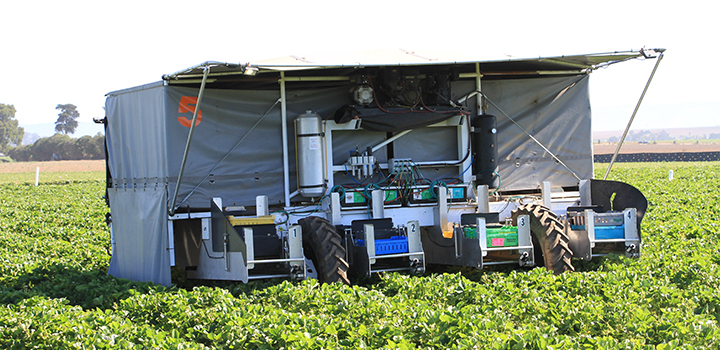Robotics on the Rise

Agribusiness Assistant Professor Timothy Delbridge, an agricultural economist, published a timely research paper in the California Agriculture journal on the economics of robotic harvesting in strawberries.
Automation projects to enhance labor efficiency is a key research priority for the California strawberry industry, which accounts for nearly 90 percent of all U.S.-grown strawberries. Strawberries are one of the state’s top five agriculture commodities, accounting for $2.2 billion in value in 2019.
The Cal Poly Strawberry Center and the California Strawberry Commission have partnered to work with faculty and students on projects to advance mechanization and robotics to automate tasks typically done with human labor to help reduce the burden on farmers in a time when competition for agricultural labor is fierce.
Delbridge’s focus on the economic feasibility of introducing advanced robotic harvesting equipment comes at a time when robotic harvesting is not yet widespread but anticipated to be used by predominantly larger growers in the next two to three years.
“The advanced technology is getting to a point where it is really close to making sense,” said Delbridge, whose research is often focused on farm-level decisions from an economic perspective of when it makes sense to make an investment or change systems based on market conditions. “This research provides those growers a benchmark for the efficiency of the equipment and the wages paid to their labor force.” Delbridge’s assessment confirms that with expected increases in wage rates in the coming years, and with modest improvements in the technical parameters, use of robotic systems will likely become profitable in some form.
Several students assisted with the research, including Jenny Ogden-Tinoco (Agricultural Systems Management, ’20), who now works as a strategic supply manager at Superior Foods, a global distributor of frozen fruits, vegetables and grains based in Watsonville, California.
Delbridge said that additional pathways of research were also inspired by the project, including a study done during the summer of 2019 focused on assessing the human harvest efficiency or extraction rate, conducted by Kale Varvel (Agricultural Business, ’20) and agricultural science senior Luis Isiah Valdez, which found that a surprising amount of fruit was being left in the field unharvested.
“The Cal Poly Strawberry Center provides an excellent opportunity to work on research in a very applied, impactful setting and at a time when decisions are being made,” said Delbridge. “Additionally, it provides a unique opportunity for students to work with the best industry data and top engineers and companies working across the industry.”
The continued partnership of the Cal Poly Strawberry Center and the California Strawberry Commission, through applied research and innovation across all disciplines, works to ensure the future growth and success of the industry. “It is the perfect time to publish this research because robotic harvesting equipment is at the stage of development that is close enough to see some of the variables taking shape, but not so close that it’s all been worked out,” said Gerald Holmes, director of the Cal Poly Strawberry Center. “This paints the way for everyone to grasp how close we are to this being a reality.”
Visit Cultivate Summer 2021 to read more stories.